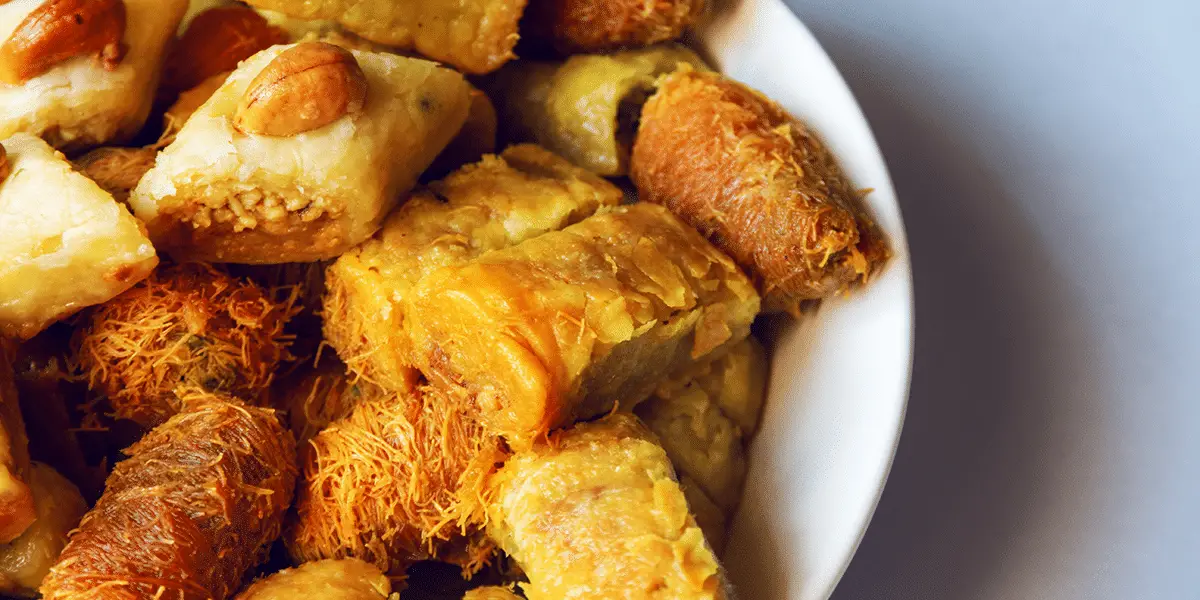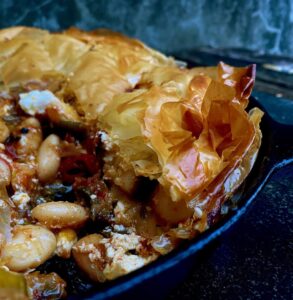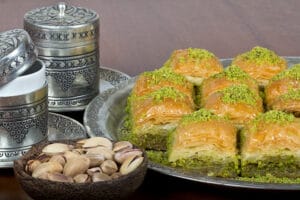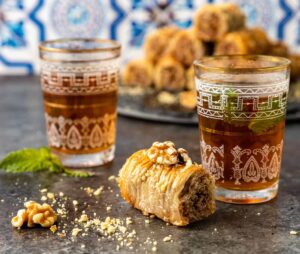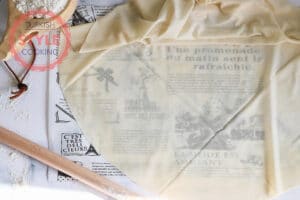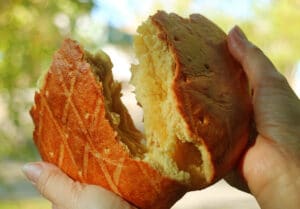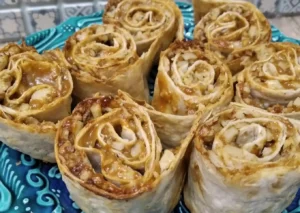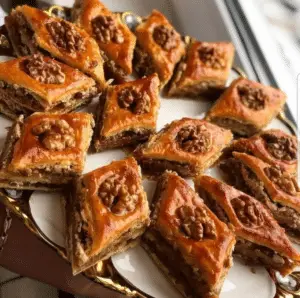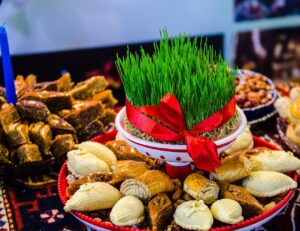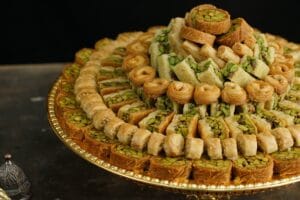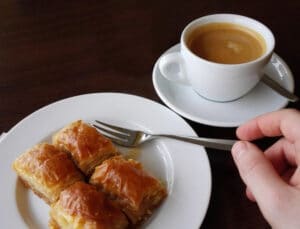Baklava (Баклава), is a delicate pastry served in numerous countries such as Russia, Turkey, and throughout the Balkans, the Middle East, the Caucuses, and Central Asia.
The recipe for the luxurious dessert typically maintains the same components: honey and nuts placed between layers of pastry. Specific countries over the centuries have added their own specific ingredients that make their particular recipe particular to their culture.
Why Is It Called “Baklava?”
Почему носит такое название?
Baklava is an ancient dish that spread widely and there are many theories of its origin and many cultures that claim to be the birthplace of the beloved desert. The earliest prototype of baklava has been suggested to have come from the Assyrians who, in 800 BCE, recorded a food consisting of unleavened bread baked in layers separated by nuts. The finished product was then coated in honey.
By the end of the Middle Ages, similar foods were eaten in Central Asia, the Mediterranean region, the Middle East, the Caucuses, and elsewhere. These foods may have been learned from the Assyrians or, given the simplicity of the recipe, independently developed in multiple places.
The word “baklava” was recorded in the Ottoman Empire during the 15th century. There, the sultan’s chefs prepared a range of savory and sweet dishes using very thin sheets of unleavened dough, separated by fats or oils, and stuffed with various fillings using legumes, vegetables, cheeses, fruits, honey, and/or nuts. The Turks called the dish “baklağu,” from an old Turkish word meaning “pile.” Eventually, baklava, in Ottoman Turkish and adopting a different suffix, came to refer specifically to the version with honey and nuts. Savory versions still exist, although they are typically known as “cheese baklava” or “bean baklava,” for instance.
In many Turkic languages, particularly in the Caucuses and Central Asia, a shift in consonant preference has led to the dish being known as pakhlava in many areas. Interestingly, both names are used interchangeably in Russia (пахлава and баклава), where extensive cultural contact has been held with cultures on both sides of the consonant shift.
The Origins of Baklava’s Diversity
(Откуда столько много видов?)
With ancient origins and a wide geographic spread, there are today diverse versions of the desert all referred to as bakava or pakhlava (and there are various spellings of each). Thus, when preparing baklava, everything from your spice profile to the number and consistency of your pastry layers will vary depending on whose baklava you are preparing.
Greeks often argue that the origin of the name comes from the Greek “plakous,” which refers to something flat and broad. Greeks prepare their baklava with phyllo dough rolled out to extraordinarily thin layers brushed with oil or butter. The term “phyllo” is of Greek origin and refers to a leaf or sheet.
In Turkey, from at least the time of the 15th Century sultans, a similar dough has been used that is called “yufka,” a term that also refers to something thin.
Both doughs will give a pastry with a consistency that is both chewy and crispy.
Italians often claim the origins of the desert to be in the 2nd Century Roman tradition of placenta cake, which layers farmer’s cheese, sweetened with honey, between layers of pastry. It was thought to improve fertility and eventually the word “placenta,” which is related to the Greek “plakous,” was applied to the uteruses, as it was also round and fertile.
Making connections between rich baklava and fertility has been common in many cultures. In the Ottoman Empire, for instance, separate recipes were once used for men and women – giving men cardamom and cloves and women cinnamon and cloves for what was thought to be maximal effect. Aromatic extracts were also added in many cultures to boost fertility, such as orange blossom, rosewater, or, particularly for the Persians, jasmin.
Armenian baklava is also known for its cinnamon and clove profile, but also claims deep Christian influence. According to local Armenian etymology, the word comes from the Armenian words “Bakh,” meaning “Lent” and “halva,” meaning “sweet.”
Religious symbolism is common in many cultures. Many (whatever the nationality) may call for exactly 40 layers, to represent each of the 40 days of Lent. Some recipes, similarly, call for 33 layers, one for each year of Christ’s life.
But so many layers are not always obligatory. In Azerbaijan, whose baklava also often contains extracts, cardamom, saffron, and/or poppy seeds, the preparation is sometimes (but not always) boiled down to something resembling a regular pie – with a rich nut filing with just two or three layers – which are often thick enough to resemble pie crust or even a particularly dense bread. This type of baklava is sometimes referred to as “ленивая пахлава” or “lazy pakhava” and is also well known in Armenia and other places.
In Azerbaijan, the pieces are most often cut into diamond shapes associated with flames, a national symbol of Azerbaijan. However, diamonds are, again, common elsewhere as well. Other cultures might cut the pieces into squares or triangles. The pieces might be gathered into spirals or rolls. They might be formed into delicate flower-like shapes. Today, for very special occasions, a variety of types and shapes will be served all at once.
For the nut filling, walnuts are most commonly used – but pistachios and hazelnuts are also common across many cultures.
It’s important to remember that all of this evolved in widely separated geographic areas and under diverse cultures. It may be the result of cultural spread and change or cultural convergence of independently developed foods or, very likely, a result of both spread and convergence. In fact, that the Ottoman Empire either ruled or had contacts with and would soon rule most of the other cultures, in fact, helps support the idea that baklava may be the result of convergent cultures being drawn upon and influenced by the ruling Ottomans. The Ottoman Empire in the 15th Century was a big, multicultural, and growing place.
How to Bake Baklava
Как правильно готовить баклаву?
With so much diversity, it’s easy to feel a bit nervous about getting the recipe right. However, given that all these variants are almost universally delicious and appreciated in their own right, it’s also quite hard to get things wrong. There are some simple pointers, however, to make your recipe turn out the best that it can be.
If you buy frozen phyllo dough, make sure that it is completely thawed before use. Make sure to add oil or butter to the sheets with a gentle hand. Putting too much will make the dish greasy, and hard to assemble. Between the layers, make sure there is filling enough so that all elements: the dough, the nuts, and the honey can be sensed and enjoyed.
Make sure that you cut the dough before it is baked. The delicate structure of the top layers, created by the baking process, can be lost if you cut afterwards.
Don’t be afraid to experiment. Modern baklava recipes can include what some consider exotic changes such as the addition of cocoa powder or cream. Baklava recipes are often prized family heirlooms, personal discoveries, and/or cultural possessions. Don’t be afraid to make your baklava truly yours!
How to Enjoy Your Baklava
Как правильно есть баклаву?
Baklava is still associated with special occasions – it is often prepared and eaten as part of large family meals marking holidays such as Easter, the days before Lent, or New Year, for example. In Central Asia, it’s associated with the ancient Zoroastrian holiday of Nowruz and also commonly served for Muslim holidays – such as Eid al-Fitr, a three-day feast held at the end of Ramadan. Jews often serve baklava on Rosh Hashanah and Purim. Baklava is still common in some areas for birthdays or weddings as well.
Until the modern era, baklava’s often labor-intensive dough and luxury ingredients have been generally out of reach to all but royalty or nobility for more frequent consumption. However, baklava, while still associated with holidays, can today be purchased in most grocery stores throughout Eurasia and beyond as a still-expensive but much more attainable snack. In fact, if you are shopping online in many countries such as Russia, you might need to try both пахлава and баклава to see the full assortment. While the terms are interchangeable in many places, some search engines still consider them as separate.
The best baklava, however, will be fresh – preferably still warm. Over time, the syrup or honey will begin to firm, changing the consistency from something that melts in your mouth to something that will take a bit more chewing. The honey can also eventually turn the dough into a soggy mess, depriving the dish of its contrasting textures (it will still be pretty good, though, to be honest). Serve it with coffee or tea and allow the contrasts of bitter drink and sweet desert to mingle in your mouth.
Let’s Cook!
Давай приготовим!
See below for a free recipe for baklava that utilizes simple ingredients like phyllo dough, nuts, honey, and sugar.
| Баклава | Baklava |
Ингредиенты
Для начинки:
Для сиропа:
Инструкции Развести сахар в 300 мл воды. Добавить мед и довести до кипения. Убавить огонь, готовить 10 мин. до загустения. Снять с огня, добавить лимонный сок и розовую воду, дать остыть. Поставить в холодильник. Духовку разогреть до 180˚ С. Масло растопить и смазать им форму для пирога. Тесто разморозить, раскатать и прикрыть влажным полотенцем. Разрезать на пласты 20х20 см. Треть пластов смазать маслом и уложить в форму друг на друга. Для начинки мелко смолоть орехи, смешать с пряностями и сахаром. Половиной этой смеси посыпать тесто, уложенное в форму. Вторую треть листов теста также смазать маслом и выложить их поверх ореховой смеси. Не приминать слои теста! Оставшимися орехами с пряностями посыпать второй слой теста и закончить выкладку последней третью листов теста. Разрезать баклаву на ромбы. Выпекать 30 мин. при 180˚ С, затем увеличить нагрев духовки до 220˚ С и выпекать 5–10 мин. Вынуть баклаву из духовки и завершить нарезку на ромбы на всю глубину теста. Не вынимая из формы, сразу же полить баклаву сиропом.
|
Ingredients
For filling:
For syrup:
Instructions Dissolve the sugar in 300 ml of water. Add the honey and bring to a boil. Reduce heat, cook for 10 minutes until thickened. Remove from heat, add lemon juice and rose water. Let cool in the refrigerator. Preheat the oven to 180˚ C. Melt the butter and grease a baking dish with it. Defrost the dough, roll it out, and cover with a damp towel. Cut into sheets of 20×20 cm (or just large enough to fit the bottom of your pan). Grease a third of the layers with the butter and pile them together. For the filling, finely grind the nuts and mix them with spices and sugar. Sprinkle half of this mixture on the dough. Grease the second third of the dough sheets with butter and place them on top of the nut mixture. Do try to press down on the dough! Sprinkle the remaining nuts with spices on the second layer of dough and finish laying out the last third of the dough sheets. Cut the baklava into diamonds. Bake for 30 minutes at 180˚С, then increase the oven temperature to 220˚С and bake for 5-10 minutes. Remove the baklava from the oven and finish cutting into diamonds to the full depth of the dough. Without removing it from the pan, immediately pour the syrup over the baklava. |
Here is another recipe commonly found in Eurasia available to all!
| «Пахлава бакинская» | Baku Pakhlava |
Тесто
Начинка
Дополнительно
Сироп
Инструкции Начнем с приготовления теста. Заливаем шафран водой (кипятком), чтоб заварился. И оставляем остывать градусов до 40. Молоко нагреваем до 40 градусов и разводим там дрожжи. Сливочное масло разогреваем в микроволновке. В миску просеиваем 3,5 стакана муки, всыпаем сахар, соль, вбиваем яйца и вливаем сливочное масло. Размешиваем. Получается тесто комочками. Вливаем в молоко с дрожжами половину разведенного шафрана (это 50 мл) и эту смесь выливаем в миску с тестом. Замешиваем. Тесто получается вязкое, липкое. Всыпаем еще 2-2,5 стакана муки и замешиваем не липкое тесто, но оно должно оставаться мягким, не забитым! Я добавляю 2 стакана и уже контролирую надо ли подсыпать еще или нет. Вот наше тесто. Гладкое, мягкое с маслянистым блеском. Кладем тесто в миску, прикрываем полиэтиленом, укутываем и ставим в тепло на 1,5-2 часа. Пока тесто отдыхает в тепле, займемся начинкой. В чаше процессора измельчаем орехи с сахаром, ванилином, кардамоном и мускатным орехом. Через 1,5 часа тесто вот так выросло. Делим тесто на 12 частей… Это количество символизируют количество слоев Земли и атмосферы. 2 комочка теста должны быть больше, чем 10 остальных. Вес общего теста 1,3 кг, вес больших 200 г, вес малых 90 г. Тесто красивого желтого цвета и очень ароматное из-за добавления шафрана! Размер формы 27-37 см. Стол подпыляем мукой. Раскатываем первый из крупных шариков. Переносим на противень при помощи складывания. И включаем духовку на 180 градусов. Посыпаем ровным слоем начинки 2-2,5 ст. л. Раскатываем первый шарик из меньших. И методом складывания переносим. Метод складывания это когда края теста складываются к середине конвертиком. Переносим тесто, разворачиваем. Растягиваем, чтоб закрывал всю начинку и прижимаем рукой, чтоб вышел воздух и слои объединились. Посыпаем ровным слоем начинки. И таким образом поступаем со всеми шариками теста меньшего размера. Слои не надо промазывать маслом! На пласт теста сыплем сразу сухую ореховую начинку! Тесто мягкое и эластичное тянется замечательно! Если случится так, что где-то порвется не пугайтесь, это не страшно! Если получится, то подтяните тесто и залепите дырочку. Если не получается, то пусть остается дырочка. После того, как все маленькие шарики уже вошли в состав пахлавы, раскатываем второй крупный шарик теста. Переносим на противень. Хорошо растягиваем, чтоб укрыл всю пахлаву. Вот с ним надо постараться максимально аккуратно! Чтоб не порвался и был раскатан максимально одинаково по толщине! Смешиваем желток с несколькими ложками оставшейся заварки шафрана и смазываем верхний слой пахлавы. Ставим пахлаву на 5-7 минут в духовку. Тем временем растапливаем масло для заливки в микроволновке. Через 5-7 минут достаем пахлаву, нарезаем аккуратно на ромбики, в каждый кусочек вкладываем по кусочку ореха. Объясню зачем ставим пахлаву на 5-7 минут в духовку перед нарезанием: верхний слой теста чуть подсыхает и не тянется за ножом, как тянулось бы сырое тесто! Заливаем растопленным маслом и ставим в духовку при 150 градусах на 50-60 минут. У меня стандартно выпекается 50 минут при указанной температуре, но духовки разные и может Вам понадобится чуть больше времени. Если у Вас духовка “сумашедшая”, то в конце выпекания прикройте верх листиком фольги. Еще Вам может показаться, что масла слишком много, но не уменьшайте количество! В процессе выпекания тесто вбирает масло, но в готовом виде пахлава не слишком жирная! Бояться не надо! Минут за 15-20 до конца выпекания варим сироп из сахара и воды. Смешиваем и провариваем минут 7-10. Готовую пахлаву заливаем сиропом и оставляем для пропитывания и остывания. Затем прорезаем по линиям еще раз и аккуратно выкладываем пахлаву на блюдo. |
Dough
Filling
Additionally
Syrup
Instructions Let’s start by making the dough. Pour boiling water over the saffron and let brew until it cools to 40 degrees. Heat the milk to 40 degrees and dilute the yeast therein. Heat the butter in the microwave. Sift 3.5 cups of flour into a bowl, add sugar, salt, eggs, and butter. Stir until you get a lumpy dough. Pour half of the diluted saffron into the milk with yeast (this is 50 ml) and pour this mixture into a bowl with dough. Knead until you get a sticky dough. Pour in another 2-2.5 cups of flour and knead until no longer sticky, but still soft and not overworked! Add the first two glasses and decide if you need more or not. Now you have your dough: smooth, soft, and with an oily sheen. Put the dough in a bowl, wrap with plastic wrap and put it in a warm place for 1.5-2 hours. While the dough resting in its warm place, let’s start the filling. Grind the nuts with sugar, vanilla, cardamom, and nutmeg in a food processor. After 1.5 hours, the dough will have grown considerably. Divide the dough into 12 parts … This number symbolizes the number of layers of the Earth and the atmosphere. Two lumps of dough should be larger than the 10 others. The weight of the total dough is 1.3 kg, the weight of the large dough portions is 200 g, while the weight of the small dough portions is 90 g. The dough is beautiful yellow in color and very fragrant due to the addition of saffron! The size of the pan is 27-37 cm. We dust the table with flour. Roll out the first of the large balls. Transfer to pan by folding. And turn on the oven 180 degrees. Sprinkle with an even layer of filling: about 2-2.5 tbsp. Roll out the first ball of the smaller ones. We transfer it by folding. The folding method is when the edges of the dough are folded towards the middle like an envelope. We transfer the dough and unfold it. We stretch it to cover the entire filling and press it with our hand so that the air comes out and the layers come together. Sprinkle with an even layer of filling. And this is how we deal with all smaller balls of dough. The layers do not need to be greased! We immediately pour the dry nut filling onto the layer of dough! The dough is soft and elastic – it will stretch well! If it happens that a break occurs, do not be alarmed – it’s not scary! If possible, pull the dough to close the hole. If it doesn’t work, then let the hole remain. After all the small balls have already entered the pakhlava, roll out the second large ball of dough. Transfer to a baking sheet. Stretch well to cover the whole pakhlava. Here you have to be as careful as possible so that it does not break and is rolled out as uniformly as possible in thickness! Mix the yolk with a few tablespoons of the remaining saffron tea and brush it onto the top layer of pakhlava. We put the pakhlava in the oven for 5-7 minutes. In the meantime, melt the butter in the microwave. After 5-7 minutes, we take out the pakhlava, cut it carefully into diamonds, put a piece of nut onto each piece. Let me explain why we put the pakhlava in the oven for 5-7 minutes before cutting: the top layer of the dough dries up a little and does not stick to the knife, as would raw dough! Pour the melted butter evenly on top and put the pakhlava in the oven at 150 degrees for 50-60 minutes. I usually bake 50 minutes at the specified temperature, but ovens are different and you may need a little more time. If your oven is “crazy”, then at the end of baking, cover the top with a piece of foil. You may also think that there is too much butter, but do not reduce the amount! During the baking process, the dough absorbs the butter, and in the finished form, the pakhlava is not too greasy! Don’t be afraid! For 15-20 minutes before the baking is completed, make a syrup by mixing the sugar and water and boiling them for 7-10 minutes. Pour the syrup evenly on the warm pakhlava and leave to soak and cool. Then cut along the lines again and carefully lay out the pakhlava on a dish. |
Our Favorite Baklava Videos
Here is a video presenting a recipe for baklava in Russian. The speaker is preparing a Turkish baklava with pistachios in her own home, taking her audience through every step of the process. Note that she also addresses the question of whether the dish should be called “Turkish,” giving her personal opinion and leaving it at that. Interestingly, the one culture she singles out as perhaps making a contrary argument is the Jewish culture. However, Jewish culture, much like Russian, has fully assimilated baklava into its common diet and traditions, but quite rarely makes a serious attempt to claim the dish as its own.
In this video, an Armenian woman is shown preparing “lazy baklava” for her family’s New Year celebration. Her accent and her family, with kids running wild around her, may be something of a distraction, but is also something that gives this video some additional entertainment value and cultural insight – for many Caucasus cultures, children are allowed and expected to be fast and loud.
Another recipe for baklava! In this video, the speaker is a bit calmer and clearer for those that are still learning Russian.
You Might Also Like
Posts not found

